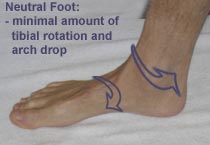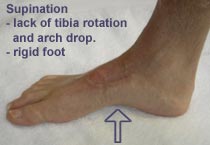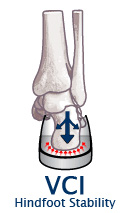Foot Pattern Copy
The most accurate way to determine your foot pattern is to have a professional observe you walking bare foot. A doctor, physical therapist or a specialty running store should be able to do this for you. Although not perfect, the “water” test can also give you some idea of your foot type. This entails getting your feet wet, walking on dry cement, and observing the prints left behind (see images above).
Please remember that foot patterns are defined by the motion of the foot (or lack thereof) through the gait cycle, and not solely the height of the arch. Although the type of heel strike can often be determined by the wear of a shoe, shoe wear does not always indicate the actual foot pattern (which occurs in the mid-stance of the gait cycle, after heel strike).
Types of foot patterns:
Supination – characterized by a high arch that remains rigid through the gait cycle.
Neutral foot / mild pronation – indicated by a minimal degree of inward rotation of the midfoot, or a mild amount of pronation, when weight-bearing.
Moderate to excessive pronation – indicated by a high degree of inward rotation of the midfoot, or “collapsing” of the medial arch, when weight-bearing. Excessive pronation, and the ensuing rotation in the kinetic chain, is a common cause of orthopedic maladies of the leg.
Flat foot – indicated by a lack of arch in the medial view of the foot when non-weight bearing. The footprint is similar to excessive pronation (when weight bearing).
Compare your feet and water footprints to the images below. All pictures were taken in a weight bearing position (standing). Once again, these images should only be used as a casual guide until you can be evaluated properly.
 |
 |
 |
| Neutral | Excessive Pronation / Flat Foot | Supination |
 |
 |
 |




